Posts Tagged home life
Mrs. Potts, Inventor

Mrs. Potts type flatiron made by A. C. Williams Company of Ravenna, Ohio, 1893-1910. THF171197
A "Cool Hand" Who Always Came to the "Point"
In the early 1870s, a young wife and mother had a better idea for making the arduous task of ironing easier. Her name was Mrs. Potts.
At this time, people smoothed the wrinkles from their clothing with flatirons made of cast iron. These irons were heavy. And needed to be heated on a wood stove before they could be used—then put back to be reheated once again when they began to cool. (Automatic temperature control was not to be had.) 
Mary Florence Potts was a 19-year-old Ottumwa, Iowa, wife and mother of a toddler son when she applied for her first patent in October 1870, one reissued with additions in 1872. Mrs. Potts’ improved iron had a detachable wooden handle that stayed cool to the touch. (Conventional irons had cast iron handles that also got hot as the iron was heated on the stove— housewives had to use a thick cloth to avoid burning their hands.) Mrs. Potts’ detachable wooden handle could be easily moved from iron to iron, from one that had cooled down during use to one heated and ready on the stove. This curved wooden handle was not only cool, but also more comfortable—alleviating strain on the wrist.
Mrs. Potts’ iron was lighter. Rather than being made of solid cast iron, Mrs. Potts came up with idea of filling an inside cavity of the iron with a non-conducting material like plaster of Paris or cement to make it lighter, and less tiring, to use. (Florence Potts’ father was a mason and a plasterer, perhaps an inspiration for this idea.)
Previous iron design had a point only on one end. Mrs. Potts’ design included a point on each end, to allow the user to use it in either direction. 
 Mrs. Potts appeared on trade cards advertising her irons. This one dates from about 1883. THF214641
Mrs. Potts appeared on trade cards advertising her irons. This one dates from about 1883. THF214641
Mrs. Potts’ innovations produced one of the most popular and widely used flatirons of the late 19th century. It was widely manufactured and licensed in the United States and Europe with advertising featuring her image. Mrs. Potts’ iron was displayed at the 1876 Centennial Exhibition in Philadelphia. Millions of visitors attended the exhibition.
The Potts iron became so popular that by 1891, special machines were invented that could produce several thousand semicircular wood handles in a single day, rather than the few hundred handles produced daily with earlier technology. Mrs. Potts' type irons continued to be manufactured throughout the world well into the twentieth century.

Though Mrs. Potts proved her inventive mettle with her innovative flatiron design, it appears that she did not reap spectacular financial rewards—at least by what can be discerned from census records and city directories. By 1873, the Potts family had moved from Iowa to Philadelphia, where her daughter Leona was born. They were still living there in 1880, when the census mentions no occupation given for any family member. Perhaps, if Mrs. Potts and her family became people of leisure, it was only for a time. Whether through need or desire, the Potts family had moved to Camden, New Jersey by the 1890s, where Joseph Potts and son Oscero worked as chemists. Joseph Potts died in 1901. By 1910, Florence and Oscero were mentioned as owners of Potts Manufacturing Company, makers of optical goods.
Mrs. Potts’ creativity made the tough task of ironing less onerous for millions of women in the late 19th century. And—though most are unaware—the story of the inventive Mary Florence Potts lives on in the many thousands of irons still found in places like antique shops and eBay.
Jeanine Head Miller is Curator of Domestic Life at The Henry Ford.
New Jersey, Pennsylvania, 19th century, 1870s, women's history, home life, by Jeanine Head Miller
Celebrating Women at Atari

The familiar silver packaging for the “Black Vader” Atari 2600 was created by Evelyn Seto, who led the Atari design team with John Hayashi. THF160364
Cardboard boxes printed in bold colors: shimmering silver, blazing orange, primary blue, circus purple—hot pink. Overlaid with white and yellow Bauhaus typography announcing the contents: Centipede, Breakout, Space Invaders. Inside the box, a black plastic cartridge that holds the promise of video game entertainment, all from the comfort of home. Games played while sitting cross-legged on the floor. Later, aching hands from hours of play on a square, non-ergonomic, one-button joystick. No quarters necessary. By the fall of 1977, there was no denying the fact that the arcade was successfully finding its way into the living room.
The Atari Video Computer System (later sold as the Atari 2600) changed the gaming industry. Earlier systems like the Magnavox Odyssey, Home PONG, and the Fairchild System F were available in the early 1970s, but the remarkable success of the Atari 2600 defined a “second generation” of home consoles, selling over 30 million units between 1977 and 1992.
The number of games available for the 2600—taking into account Atari and Sears releases as well as those by third-parties like Activision and Imagic—finds us looking at approximately 550 unique titles. Several games within this vast library include important contributions made by women.
Female employees were not uncommon at the company. Carol Kantor became the first market researcher at a video game company, ever. Wanda Hill drew the circuit diagrams for Asteroids. Judy Richter worked as a packaging designer and production manager for a decade, through multiple leadership transitions. The people working on the assembly lines populating the circuit boards for arcade games were almost all women. Evelyn Seto supervised the design team, inking the original three-pronged “Mt. Fuji” logo and creating the shelf-appealing silver packaging for the Atari 2600. Dona Bailey and Ed Logg’s 1980 arcade version of Centipede was translated as a “port” for the Atari 2600 in 1982. In 2013, this cartridge was excavated from the “Atari Tomb” located in an Alamogordo, New Mexico landfill. THF159973
Dona Bailey and Ed Logg’s 1980 arcade version of Centipede was translated as a “port” for the Atari 2600 in 1982. In 2013, this cartridge was excavated from the “Atari Tomb” located in an Alamogordo, New Mexico landfill. THF159973
The scales were not exactly balanced in terms of gender equality within Atari’s engineering staff, but take for instance the work of Dona Bailey, programmer of the arcade version of Centipede (1980). Not only was she the first female programmer to design an arcade game, but her collaboration with Ed Logg led to the creation of one of the most iconic video games of all time.
When Carol Shaw created 3D Tic-Tac-Toe, she became the first professional female video game developer. THF171081
Carol Shaw & Susan Jaekel
Dona Bailey’s time in the “coin-op” division at Atari overlapped with Carol Shaw’s work for the “cart” division. In 1977, Shaw graduated from the University of California, Berkeley’s Computer Science program, and was hired as the first female programmer at Atari in August 1978. When she completed her first cartridge game that year—3D Tic-Tac-Toe—she effectively became one of the women to work in the professional video game industry. 3D Tic-Tac-Toe is an abstract strategy video game based on a game called Qubic, which was originally played on room-sized computers in the mid-1950s.
In the 1970s and 80s, the exterior graphics of a coin-op console or the illustration on a game’s cardboard box were often a player’s first exposure to a game. Typically, the vibrant and dynamic graphics promoting a game were light years beyond the pixelated game that showed up on the screen. Nonetheless, Evelyn Seto from Atari’s graphics team once said: “The romance of the game was told in the box artwork.”
And what could be more intriguing than a woman in space with her spacesuit-clad dog competing against a robot with laser-powers? The illustrations on 3D Tic-Tac-Toe’s box were painted by Susan Jaekel, who became known for her illustrated textbooks and cookbooks, as well as the packaging for Atari’s Adventure, Circus, Basic Math, and others. On 3D Tic-Tac-Toe, Jaekel collaborated with Rick Guidice to create the four grids in the design; Guidice is well-known for his 1970s illustrations of space colonies for NASA’s Ames Research Center.
In 1978, Shaw also programmed Video Checkers and Super Breakout (with Nick Turner). In 1982, Shaw left Atari to work for Activision, where she created her most celebrated game: River Raid. River Raid by Carol Shaw. Activision was the first third-party video game developer, making compatible cartridges for the Atari 2600. THF171080
River Raid by Carol Shaw. Activision was the first third-party video game developer, making compatible cartridges for the Atari 2600. THF171080
River Raid is a top-down-view scrolling shooter video game. Players move a fighter jet left to right to avoid other vehicles, shoot military vehicles, and must refuel their plane to avoid crashing. The game was pioneering for its variation in background landscape. Whereas most games repeated the same background, Shaw found a way to create a self-generating algorithm to randomize the scenery.
In an interview, Carol Shaw spoke of how “Ray Kassar, President of Atari, was touring the labs and he said, ‘Oh, at last! We have a female game designer. She can do cosmetics color matching and interior decorating cartridges!’ Which are two subjects I had absolutely no interest in…” Detail of River Raid instruction manual, introduced by Carol Shaw.
Detail of River Raid instruction manual, introduced by Carol Shaw.
Carla Meninsky
In Atari’s early years, Carla Meninsky was one of only two female employees in Atari’s cartridge design division, along with Carol Shaw. When Meninsky was a teenager, her programmer mother taught her the basics of Fortran. Carla’s academic studies at Stanford began in the mathematics department, but she switched to a major in psychology with a focus in neuroscience. In school, she became interested in building an AI-powered computer animation system and spent her free time playing the text-based Adventure game. Soon after graduation, she pitched her computerized animation idea to Atari, and was hired. Almost immediately, she found herself shuttled into the unintended role of game programmer, working through a list of proposed titles with no actual description.  Carla Meninsky and Ed Riddle’s Indy 500 was one of the first of nine titles released with the Atari 2600 launch. THF171078
Carla Meninsky and Ed Riddle’s Indy 500 was one of the first of nine titles released with the Atari 2600 launch. THF171078
Meninsky co-designed Indy 500 with Ed Riddle. When the Atari 2600 launched, this was one of the first nine titles advertised. The game was a bird’s eye view racing game that was a “port” made in the spirit of full-size coin-op arcade games like Indy 800, Grand Trak 10, and Sprint 4. This game could be used with the standard controller, or a special driving controller with a rotating dial that allowed players to have greater control over their vehicles.  Dodge ‘Em is another driving maze game designed by Carla Meninsky, and was one of the first games she created for Atari. THF171079
Dodge ‘Em is another driving maze game designed by Carla Meninsky, and was one of the first games she created for Atari. THF171079 Carla Meninsky’s Star Raiders, 1982. THF171076
Carla Meninsky’s Star Raiders, 1982. THF171076
Star Raiders, also by Meninsky, is a first-person shooter game with a space combat theme. The game was groundbreaking for its advanced gameplay and quality graphics that simulated a three-dimensional field of play. The original version of the game was written by Doug Neubauer for the Atari 8-bit home computer and was inspired by his love for Star Trek. This “port” to the home console market for the Atari 2600 was programmed by Carla Meninsky.
 Star Raiders came with a special Video Touch Pad controller. The Henry Ford’s collections house the version sold with the 1982 game, as well as a crushed and dirtied version that was excavated from the “Atari Tomb” in 2013. THF171077 and THF159969
Star Raiders came with a special Video Touch Pad controller. The Henry Ford’s collections house the version sold with the 1982 game, as well as a crushed and dirtied version that was excavated from the “Atari Tomb” in 2013. THF171077 and THF159969
The 2600 version of the game could be used with a regular joystick, or a deluxe version was sold with a special Video Touch Pad controller. This twelve-button touchpad was designed to be overlaid with interchangeable graphic cards, printed with commands for different Atari games. Star Raiders was the only game to make use of this controller—perhaps if it weren’t for the looming “Video Game Crash” of 1983, other developers would have made use of this controller.
Atari was one of the first companies with the types of workplace perks that are now ubiquitous at Silicon Valley companies today. It had a reputation for attracting the young, the rebellious, and the singularly talented. While certain aspects of Atari’s workplace culture might raise eyebrows today (and rightly so), it also doesn’t take much digging to find stories of women who were empowered to make vital contributions to the company. These recent artifact acquisitions—games designed and programmed by female gaming pioneers working at Atari—embody an ambition to represent and celebrate diverse cultures through our technological collections.
Kristen Gallerneaux is the Curator of Communications and Information Technology at The Henry Ford.
toys and games, California, 20th century, 1980s, 1970s, women's history, video games, technology, home life, design, by Kristen Gallerneaux
Losing Weight, 1972-Style

Jar of Weight Watchers “Sweet’ner,” 1972. THF170107
Many diet plans have come and gone. But, through its innovative approach and changing strategies that attempt to keep up with the times, the Weight Watchers program has endured for more than 50 years. Recently, we came across this rather mysterious jar of Weight Watchers sugar substitute from 1972. This led us to unearth the intriguing origins and changing strategies of the Weight Watchers program as well as the ongoing controversies about non-caloric sweeteners.
Weight Watchers was founded in 1963, by Jean Nidetch, an overweight, 40-year-old homemaker living in Queens, New York. Constantly struggling with dieting but never able to keep off her weight, she called up a few friends one day to come over and share their weight loss struggles. Within a short time, these meetings became so popular that she began to arrange support group meetings and realized that by sharing their stories and supporting each other, people were starting to change their eating habits. Al Lippert, a merchandise manager who lost 40 pounds through these weekly meetings, began to give Nidetch advice on how to organize and expand her activities and soon a four-person partnership was formed among Nidetch and her husband, Marty, and Al and Felice Lippert. In May 1963, Weight Watchers was incorporated and opened for business in Queens, New York.
This jar of “Sweet’ner” mostly contained saccharin. The 1972 Weight Watchers program did not permit the consumption of sugar (except in “legal” recipes) and, instead, promoted the use of its artificial sweetener in all recipes, dishes, and beverages. The promise of this simple-to-use, calorie-free product helped bring new members into the program. At the same time, Weight Watchers introduced a new line of artificially sweetened foods and sodas. 
Booklet with “calorie saving recipes” using Sucaryl (cyclamate), 1955. THF286634
Synthetic sweeteners have always seemed like miracle foods. The promise of a calorie-free treat or drink has had a stronger pull than the health and safety risks that might accompany them (such as causing cancer or possibly actually encouraging weight gain). This is why it seems that, as soon as one sweetener is declared dangerous, the next big sweetener is just around the corner. Saccharin, accidently discovered in 1897 by a Johns Hopkins University researcher, was the first widely used artificial sweetener. But some thought it to be dangerous and toxic. The introduction of a sweetener called cyclamate, discovered 1937, replaced it in popularity and it coincided with the diet soda boom of the 1950s and 1960s. But the use of cyclamates came to a halt when it was banned by the FDA in 1969, as it was found to cause cancer in rats. Saccharin, by then popular in Sweet ‘n’ Low, was banned in 1981 for its cancer-causing risks but it was unbanned in 2010 in more than 100 countries, including the United States. Meanwhile, other non-caloric sweeteners became popular, including Aspartame (used in NutraSweet and Equal) and Sucralose (used in Splenda). Each of these came with health and safety risks.
Despite competition, food fads, and uneven business expansion efforts, Weight Watchers has maintained its dominance in the weight loss business and, through continual refinement and addressing consumer needs, remains as popular as ever.
Donna R. Braden is Curator of Public Life at The Henry Ford.
20th century, 1970s, home life, healthcare, food, by Donna R. Braden
A 1960s Christmas, Then and Now
Nostalgia for those who experienced it—and a hip mid-century modern revival for others.

The Visits with Santa experience in Henry Ford Museum of American Innovation this year is a throwback to the 1960s. Kids can tell Santa their wishes as they sit next to him under a colorful kiosk made by Ray and Charles Eames for the IBM pavilion at the 1964 New York World’s Fair. Nearby is a cozy 1960s living room vignette—complete with a La-Z-Boy chair, television set, and an aluminum Christmas tree from the era.
This mid-century modern theme coincides with the opening of our newest permanent exhibit in the museum, Mathematica, also designed by Ray and Charles. Several components of Mathematica were featured inside that IBM Pavilion at the 1964 World’s Fair, so we were excited to bring those two experiences together for this year’s holiday programming.
The scene provides a bit of nostalgia for those who experienced the 1960s—and a hip mid-century modern revival for others. Let’s look at some blasts from the 1960s Christmas past.

Aluminum trees brought a modern look to a mid-1960s Christmas. THF170112
The early 1960s brought a fresh, new look to Christmas tree aesthetics. A completely modern look--the aluminum Christmas tree. It made a shiny, metallic splash in living rooms all over America. More than a million trees were sold during the decade. A tree choice that eschewed the traditional pine- or fir-scented Christmas experience when it landed on the Christmas scene in the 1960s, now conjures up images of a retro Christmas past.

Color wheel sold by Sears, Roebuck and Company, 1960-1965. THF8379
A color wheel lit up the aluminum tree, with the tree changing from blue to red to green to gold as the wheel revolved. The color wheel was there for a practical reason—you couldn’t put strings of lights on aluminum trees because of fire safety concerns. But to those viewing the transformation, the color wheel seemed a no-brainer way to light these trees—so modern and so magical. It was mesmerizing to watch—whether from a front row seat in your living room or the view through your neighbor’s window.
The Smith family of Redford, Michigan purchased these ornaments in 1964 to hang on their aluminum Christmas tree. THF309083
Aluminum trees called for minimalist look. The trees were often sparingly decked with ornaments all of one color.

The Wojewidka siblings pose for a Christmas photo in front of their live tree in 1960. THF125145
Yet, “real” trees remained popular as well—fresh-cut trees chosen from one of the many temporary Christmas tree lots that popped up in cities and towns. (The cut-your-own trend was not yet widespread.) Scotch pines were favored by many—though there were diehard balsam fans as well. These trees were bedecked with a varied array of ornaments—glass ones by the Shiny Brite company were popular. And shiny “icicles”—made of lead before it was prohibited—hung from the branches to add to the sparkle.
Holiday Greetings in the Mail
By the early 1960s, Christmas cards offered a greater variety of seasonal images beyond those traditionally found. This image shows a woman clothed in a pine tree decorated with 1960s trendy-colored ornaments. THF287028
By mid-December, mailboxes were filling with Christmas cards, sent by family and friends to let the recipient know that they were being specially thought of during the holiday season. It was exciting to pull out handfuls of cards from the mailbox—it may have been the only time during the year when a kid had much interest in what the postman delivered. And not necessarily because of the cards themselves—the cards were a tangible sign that Christmas was indeed on its way and that Santa would soon be making his deliveries!

Christmas card display clothesline and pins, about 1964. THF155082
Where did people display all these Christmas cards? On a mantle, a table, or the top of the television. Or taped to a wall or a large mirror in the living room. Hanging them from a Christmas-themed clothesline was a more novel way to display them.
This 1962 stamp carried traditional Christmas images of lighted candles and a wreath. THF287036
In 1962, the United States Postal Service issued the first Christmas-themed postage stamps in America. (A few other countries had already beaten us to the punch on issuing Christmas-themed postage stamps.) But once begun, Christmas stamps graced more and more Christmas card envelopes to complete the annual presentation of holiday-themed greetings sent through the mail.
Making a List
Christmas catalogs like this 1964 Sears, Roebuck & Company got a workout in December. THF135874
Kids were busy deciding what to ask Santa for. Instead of perusing the web, kids looked forward to the arrival of Christmas season catalogs sent by stores like Sears, Roebuck and Company, J.C. Penney, and Montgomery Ward. Kids (and adults) eagerly leafed through the pages of the toys, clothing, and other gifts offered within, making their wish list for Santa’s perusal before passing the catalog along to another family member.
Television offered additional gift ideas, playing out the merits of products before viewers’ eyes in commercials that one couldn’t speed past with a DVR.
Toys for Girls and Boys
Many 1960s toys that appeared on the Christmas lists of millions of kids during the 1960s—some in updated versions—are still classics.

Silly Putty modeling compound, about 1962. THF135811
Silly Putty was invented during World War II as General Electric researchers worked to develop a synthetic substitute for rubber. While no practical purpose could be found for the stuff, it did turn out to be a great toy. Silly Putty bounced higher and stretched farther than rubber. It even lifted images off the pages of color comics. (My sister took Silly Putty to bed with her, leaving a perfect egg-shaped stain on the sheets that never came out.)

Eight-year-old Rachel Marone of New York received this Etch A Sketch as s Christmas gift in 1961. THF93827
The 1960s saw an innovative new arts and crafts toy—the Etch A Sketch. Turning the knobs at the bottom of the screen (one to create horizontal lines, one for vertical) let the user “draw” on the screen with a mixture of aluminum powder and plastic beads. To erase, you just turned the screen over and shook it. Incidentally, it was the first toy that Ohio Art, its manufacturer, ever advertised on television. (Accomplished users could make great drawings on the Etch A Sketch—and some of us were just happy to produce decent-looking curved lines.)

This 1962 Play-Doh Fun Factory was a childhood toy of Mary Sherman of Minnesota. THF170363
Play-Doh introduced their Fun Factory in 1960. Now kids could go beyond free-form modeling with their red, yellow, blue and white Play-Doh. The Play-Doh Fun Factory provided instructions on how to create things like trains, planes, and boats—and an extruder with dies to easily make the components.
Watching Christmas Specials on TV
Album from A Charlie Brown Christmas television special, about 1965. THF162745
Kids eagerly listened for announcements on television or leafed excitedly through TV Guide magazine to find out when the holiday specials would air. You didn’t want to miss them—it was your only shot at watching! There were no DVRs or DVDs back then. Two animated classics from the mid-1960s--A Charlie Brown Christmas and How the Grinch Stole Christmas--are among the earliest and most enduring of the Christmas specials developed for television.
Within their engaging storylines, these two shows carried a message about the growing commercialization of the holiday. As kids watched the barrage of toy ads that appeared with regularity on their television screens and leafed through catalogs to make their Christmas lists, seeing these cartoons reminded them that Christmas was also about higher ideals—not just about getting presents. These television shows—and the increasing number and variety of Christmas specials that have since joined them—remain a yearly reminder to temper one’s holiday-related commercialism and to think of the needs of others.
Not only have Charlie Brown and the Grinch become perennial favorites enjoyed by children and adults alike, but the soundtracks of these shows have joined the pantheon of musical Christmas classics.
Christmas Music
The Ronettes’ version of Sleigh Ride, with its freshly melodic “Ring-a-ling-a-ling Ding-dong ding” background vocals on this 1963 Phil Spector-produced album, has become an iconic Christmas classic. THF135943
What would a 1960s Christmastime be without Christmas-themed music heard on the stereo at home and over speakers in stores? The 1960s saw a flood of Christmas albums and singles. Various singers—like Andy Williams, Nat King Cole, Perry Como, Johnny Mathis, Brenda Lee, Ella Fitzgerald, Elvis Presley, the Ronettes, the Crystals, and the Beach Boys—recorded their versions of old favorites and new tunes.
The Annual Christmas Photo

In 1963, the Truby brothers of Royal Oak, Michigan, posed in Santa pajamas given to them by their grandmother. THF287005
After the presents were opened and everyone was dressed in their Christmas finery, it was time to round up the kids for photos. Siblings (and, sometimes, their parents) might be posed together in front of a seasonal backdrop like the Christmas tree or a fireplace. Some families filmed home movies of their celebrations. These home movies often captured only strategic snippets of the Christmas celebration—movie film was expensive. And these home movies were without sound—which was probably sometimes a good thing!
Jeanine Head Miller is Curator of Domestic Life at The Henry Ford.
1960s, 20th century, home life, toys and games, popular culture, holidays, Henry Ford Museum, events, correspondence, Christmas, by Jeanine Head Miller
Electricity? I’ll Take a Pound…

When Thomas Edison decided to develop a commercial lighting system he had to do far more than design a light bulb and generator: he and his collaborators had to devise the entire system -- right down to the wire insulation and fuses. Even the electrical measuring instruments that were needed to chart the progress of experiments had to be sought from other fields such as telegraphy.
Edison demonstrated his lighting system to the public for the first time in December 1879, but the system was hardly a workable commercial product. Many refinements -- to increase durability, reliability, and cost-effectiveness -- would be needed before his lighting system could be described as a competitive product. One of the most important missing elements was a meter for keeping track of customers' electricity usage. The electrical meter that Edison and his collaborators devised was an ingenious device -- an arrangement that allowed the amount of electricity a customer used to be weighed.
The meter, known as the Edison Chemical or Electrolytic Meter, was in essence a laboratory apparatus installed in the basements of customers' buildings. It consisted of two glass jars filled with a zinc sulphate solution; immersed in each jar were a pair of electrodes -- matched pairs of zinc plates. The operation was deceptively simple. A portion of the current flowing into the customer's electrical system passed through the plates, causing an electrolytic reaction. The more electricity a customer used, the more zinc would be transferred from one plate to the other. It was this difference in weight that allowed the electrical bill to be determined. Usage was calculated on a monthly basis: an Edison employee would replace the previous month's plates with a new set whose weight had already been carefully recorded. The old plates were taken away to have their weight checked and a bill calculated. The body of the meter had to be tough and tamper-proof -- hence the term "ironclad" that was used to describe this all-metal meter. Later units were wooden boxes with a metal door. In either case, the enclosure was secured with the kind of lead seal that is still used to guard modern electric or gas meter mechanisms.
Meters like this remained in service in some installations well into the 1890s. Many customers were distrustful of this metering method, asserting that the plate removal and remote calculations allowed them no way of checking whether the company was padding their bills. Modern numerical meters allow consumers to see a read-out of their electricity, gas, or water usage. However, the meters' settings -- and indeed the consistency of different meters -- is still something we trust to the utility company.
home life, by Marc Greuther, power, electricity, Thomas Edison
The Dog Days of Summer
Is the saying, “dog days of summer,” about dogs? Not directly; at least, not about any farm dog (or city dog) we know. Instead, the “dog” is Sirius, the nose of the constellation, Canis Major, and the brightest star in the night sky. We get the best look at the constellation between November and April, but during late summer in the Northern hemisphere, Sirius appears in the eastern sky before dawn, and “rises” with the sun. Ancient Greeks considered Canis Major a homage to Orion’s greater hunting dog, Laelaps. Ancient Egyptians associated the rising of Sirius with the sun, and believed the “double sun” created the hottest season of the year. Today when we hear, “Sirius,” we might first think if Sirius Black, Harry Potter’s godfather, and not about the association between the star, Sirius, and summer heat. Let’s not forget the historic association between the hot “dog days of summer” and Sirius’ rising in tandem with the sun (July 22 through August 23).
During these “dog days,” let’s take a look at some of the photographs in The Henry Ford's collections, and think more about the dogs and the people that posed with them.

Woman Feeding Cats and Dog in a yard, circa 1900. THF211312
Can we tell whether Nellie consider her cats, or her dog as her “best friend”? It is difficult to tell because the image indicates that she paid attention to both the felines and the canine. A closer look indicates that the dog has a collar and that Nellie is either feeding him a treat or has a stick as a chew to distract him from the cats at the feed bowl.

A Young Girl and Her Dog, circa 1865. THF226464
Other photographs remind us that dogs lure us into a relaxed state. This carte-de-visite of a girl and her dog, taken in a photographer’s studio, shows a remarkably relaxed pose given the often formal and stiff portraits of the Civil War era. How many of us spend hours lounging with our own dogs?

John Burroughs with His Dog, “I Know,” 1885-1890. THF113982
Famous men struck poses with their favorite dogs, too. This photograph of internationally renowned naturalist, John Burroughs, shows him at eye level with his dog, “I Know,” sometime between 1885 and 1890. A closer look at “I Know” indicates that he has some border collie features, including his alert view and focus beyond the camera, the furry, light-colored ruff, and the white blaze on his face.

John Burroughs at his birthplace, Roxbury, New York, 1918. THF241519
A photograph taken thirty years later (1918) shows John Burroughs at his birthplace in Roxbury, New York, with another attentive border-collie-type dog. This photograph could be of anyone anywhere with a loyal canine pet.

Trade Card for Cultivating Tools, Syracuse Chilled Plow Co., circa 1880. THF225590
Do your hunting expeditions involve dogs? A trade card advertising Syracuse Chilled Plow Company cultivators, featured a colorful scene of a hunter with two bird dogs.

"Eager for Deer," Man and Dogs Ready for Hunting in the Woods, circa 1903 THF118863
Working dogs had jobs to do, but they also bonded with their handlers. A photograph of a man sitting on a felled tree has seven hunting dogs close in proximity, including one in his arms. At least one of the dogs is on a chain, and most have collars, tools which helped hunters controlled the pack of dogs that they used to flush out deer or other game from heavily wooded areas.

Edsel Ford with His Pet Dog at the Ford's Edison Avenue House, Detroit, Michigan, circa 1908. THF95291
Other dogs lived more of a life of leisure. A photograph of Edsel Ford taken around 1908, had the following inscription on the back: "Edsel & his dog, sitting on step that goes down into our garden. Garrage (sic) in rear.” Clara Bryant Ford likely took the photograph and wrote the description. It was taken at the Edison Avenue Home in Detroit.

Boy on a Bicycle Holding a Dog, circa 1950. THF201327
Compassion can make young men do some surprising things to protect their dogs. Some dogs romp in the snow, but this fellow seems to be sparing his little rat terrier the shock by giving him a ride on the back of his bicycle.

Little Snoopy pull toy, 1968-1975. THF97420
Numerous images of dogs and of objects featuring dogs exist in the collections of The Henry Ford. How many of our parents thought they could use a “Little Snoopy” pull toys to distract us from the craving for a real dog?
You can see more dog-related items in The Henry Ford collections here.
Debra A. Reid is Curator of Agriculture and the Environment at The Henry Ford.
The Artistry of Salt-Glazed Stoneware
 Four Gallon Stoneware Crock, 1878-1896. THF133277
Four Gallon Stoneware Crock, 1878-1896. THF133277 In 19th-century America, sturdy waterproof stoneware pottery became popular for utilitarian items such as crocks, jugs, and butter churns. The rough-textured outer glaze was created when common rock salt was thrown into the kiln during firing, which vaporized and combined with melted silica from the pottery.
In 19th-century America, sturdy waterproof stoneware pottery became popular for utilitarian items such as crocks, jugs, and butter churns. The rough-textured outer glaze was created when common rock salt was thrown into the kiln during firing, which vaporized and combined with melted silica from the pottery. The blue decoration--made with a cobalt oxide glaze mixture--lent variety and artistry to these otherwise plain pieces.
Today, House Industries has their own salt-glazed pottery project with Eldreth Pottery.
The pottery is one of the few manufacturers in the world that continues to employ the centuries-old technique of glazing ceramics with salt during the firing process. The application is difficult to control, giving each piece of stoneware a unique texture and distinctive colored finish.
See their pottery inspiration examples in "A Type of Learning" in Henry Ford Museum of American Innovation and learn more about the ongoing artistry of salt-glazed stoneware in our digital collections.
A Feather Duster for Your Flivver

Many of us like to keep our cars clean. Whether it’s with a trip through the automatic car wash, or a hosing and waxing in the driveway, we try to keep the mud, dirt and grime away. Some of us spend just as much time on the interiors, crawling over seats with a shop vac in hand. A car is a big investment and, the more expensive something is, the better care we’re likely to give it.
An automobile was no less an investment a century ago. Even at its absolute lowest price of $260 in 1924, a Ford Model T cost one-fifth of the average annual wage in the United States. Not surprisingly, many car owners took great pains to keep their cars neat and tidy – both to ensure that the vehicle remained in top condition, and as a more basic point of pride. We recently acquired one of the key tools for a fastidious flivver owner – an “Automobile Special” feather duster from the 1920s.
A look at period mail-order catalogs reveals any number of cleaning products available to motorists in the 1910s and 1920s. Montgomery Ward’s 1916 supplemental automobile equipment catalog grouped its cleaning products under the breezy heading, “A Clean Auto Means a More Attractive Auto.” Its pages include a mix of waxes and polishes easily recognizable today, along with archaic products like “Neats Foot Oil Clutch Compound” (used to soften a leather-surfaced clutch that engaged too abruptly). The mail-order giant’s larger Catalog and Buyer’s Guide No. 93 from 1920 devotes most of page 894 to car cleaning. Ward’s offered waxes, enamels, rubber floor mats, horsehair washing brushes, and renewing compounds for leather roofs. The duster advertised on that page is captioned with a helpful – and persuasive – warning: “Do not let dust remain on the finish of your car as it quickly works its way into the paint which kills the luster.”
On that note, our “Automobile Special” duster likely wasn’t recommended for exterior surfaces. Those ten-inch turkey feathers – with their tendency to scratch – would scare off any discerning car owner, then or now. The choosy motorist would have selected a “dustless duster” with chemically-treated fibers designed to absorb dust rather than push it around. They were readily available 100 years ago but, naturally, they came at an extra cost – 35 cents versus 14 cents for a comparable feather duster. Nevertheless, a feather duster could have been safely used to tidy up an auto’s interior surfaces, and many surely were.
While we have other feather dusters in the collection, they likely were intended for use in the home. None is specifically labeled as being for automotive use. This newly-acquired “Automobile Special” duster is an important piece – rough on the paint or not – in that it gets us to the stories of automotive maintenance and pride of ownership in the 1920s, when automobiles were priced within reach of most Americans.
Matt Anderson is Curator of Transportation at The Henry Ford.
The Search for Home
Detroit Reacts to the Great Migration: Before the first World War, a majority of Detroit's African American population lived on the East Side and shared the area, known as Black Bottom, with white immigrant populations. At this time, relatively few African Americans, just 1.2% of the total population, called Detroit home. By 1930, the city’s African American population had grown by over 1,991%. The white immigrant population began to vacate the Black Bottom area and were quickly replaced with the growing population of African Americans attracted to the north by the promise of employment in Detroit’s booming auto industry and an escape from the rampant oppression of the south. As the African American population in Detroit increased, racial residential boundaries began to form, due in part to the stress on housing stock, as well as to outright discrimination in institutions such as employment and real estate.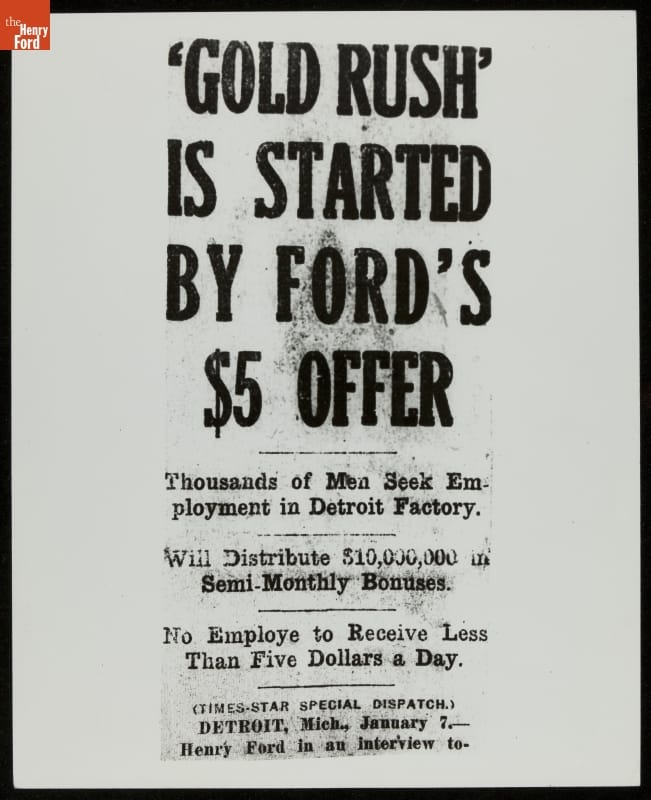
Photographic print - "Newspaper Article, "Gold Rush is Started by Ford's $5 Offer," January 7, 1914" - Ford Motor Company
The automobile industry and Henry Ford’s highly-publicized $5-a-day helped to draw people in great numbers to the Detroit area. However, for African American workers, reality often differed from their hopes and expectations in the north. While many of the automotive manufacturers did hire African Americans, it was almost always for the lowest paying jobs, such as in the janitorial department or the foundry. Ford Motor Company led the automotive industry in its hiring of African American workers by 1919. The company paid African American workers the same rate as their white counterparts and hired for a variety of positions, including skilled labor. Across the board, however, African American workers made less money than their white counterparts, and consequently, had less income for quality housing.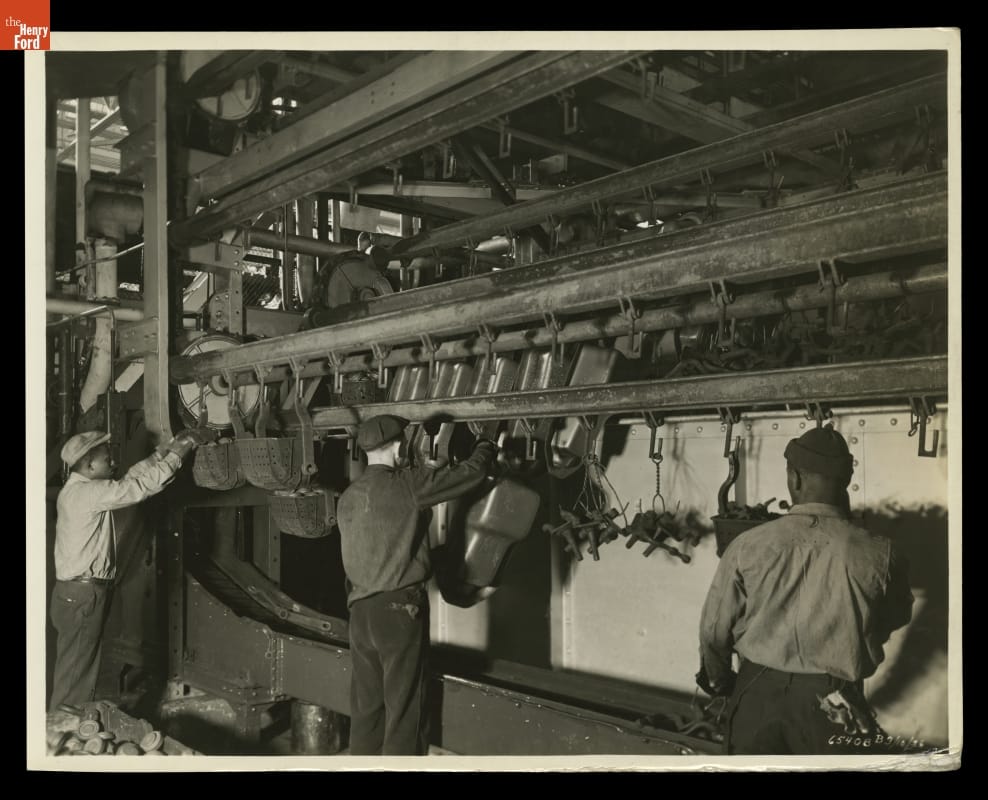
Photographic print - "Pickling Metal Crankcases and Other Parts to Remove Surface Impurities, Ford Rouge Plant, 1936" - Ford Motor Company Photographic Department
Discriminatory real estate practices played a significant role in the housing issues which plagued Detroit. Racially restrictive covenants, which legally ensured the sale of property to only white buyers, became increasingly common in Detroit. Even if a restrictive covenant was not in place, the Detroit Real Estate Board warned area realtors “not to sell to Negroes in a 100 percent white area,” thereby enforcing and perpetuating Detroit’s racial geography. Further, the practice of “redlining,” or the racial categorization of areas by their perceived financial risk in home insurance and mortgage lending, effectively shut out black homebuyers from the market. The practice extended to the lending of new mortgages, but also to home loans, leading to the inability to complete home repairs and, eventually, an abundance of blighted homes in black neighborhoods. In addition, real estate agents erroneously reported to white homeowners that the presence of black families in their neighborhoods would lower their property values. White homeowners, even those without ingrained prejudices against African Americans, certainly did not want their property values to lower, so rallied against any attempt by an African American homebuyer purchasing in their neighborhoods. The infamous story of African American Physician Dr. Ossian Sweet exemplifies the discrimination and mob violence experienced by those who attempted to move into white neighborhoods.
Discrimination in the workplace meant that African Americans, as a whole, made significantly less money than their white counterparts. Redlining practices forced them into racially-segregated neighborhoods and cemented their inability to access loans for mortgages or home repairs. Yet, the promise of the north continued to draw African Americans to Detroit. Without access to capital, increasingly-crowded neighborhoods became increasingly-deteriorated. At each turn, discriminatory systems excluded an entire population from quality housing. From these conditions, Charles H. Lawrence and his family departed Detroit in search of quality housing and a better life. He became the first African American to settle in Inkster, Michigan, and hundreds soon followed.
African Americans Settle in Inkster
The City of Inkster, also located in Wayne County, is approximately fourteen miles from downtown Detroit. Detroit Urban League President John Dancy fielded many housing inquiries from frustrated African American migrants to Detroit in the post-World War I period and beyond. Unable to locate sufficient housing in the City of Detroit, Dancy broadened his search outside the City with hopes that more rural areas would not have the same restrictive covenants and that lesser demand would persuade landowners to sell to African American buyers. In 1920, Dancy succeeded when he found amenable property owners in possession of 140 acres in rural Inkster. Although Inkster’s first African American residents’ settlement in Inkster preceded Dancy’s discovery, the 140 acres of available land enabled and impelled hundreds more African American families to move from Detroit to Inkster, despite the lack of a local government or basic public amenities like streetlights or sewer lines.
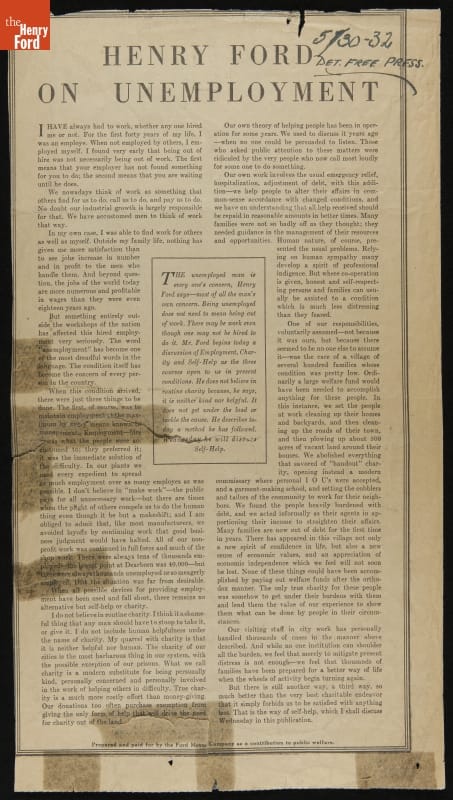
Clipping (Information artifact) - ""Henry Ford on Unemployment," 1932" - Detroit Free Press (Firm)
A Community Becomes a Project
Henry Ford was vocal about his disdain for institutionalized philanthropy. He wrote an entire chapter, entitled “Why Charity?” in an autobiography, and explained, “philanthropy, no matter how noble its motive, does not make for self-reliance…A philanthropy that spends its time and money in helping the world to do more for itself is far better than the sort which merely gives and thus encourages idleness.” Henry Ford’s brand of philanthropy was characterized by helping people help themselves. During the Great Depression, Henry Ford was called upon by the City of Detroit to provide aid because the City’s welfare offices were overwhelmed. Their argument, aside from civic responsibility, was that the City was not receiving taxes from Ford Motor Company (FMC’s factories were located outside Detroit) yet as many as “36 percent of the families receiving care from the City of Detroit were former Ford employees” in 1931. The public goodwill that Ford’s $5 a day policy brought was quickly dissipating. In 1931, Ford agreed to two philanthropic ventures; he provided a low-interest, short-term $5 million loan to the City of Detroit and essentially took the then-Village of Inkster under the Ford Motor Company’s auspices.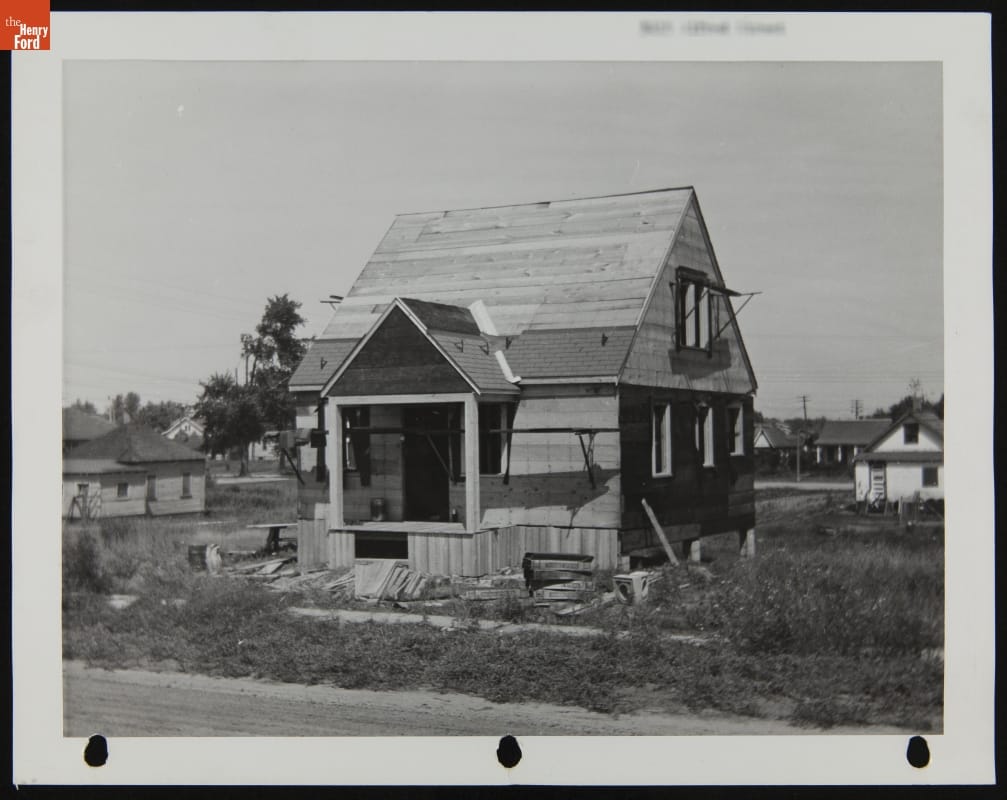
Photographic print - "Ford Motor Company Employee Home Improvement Project, Inkster, Michigan, 1930-1944" - Ford Motor Company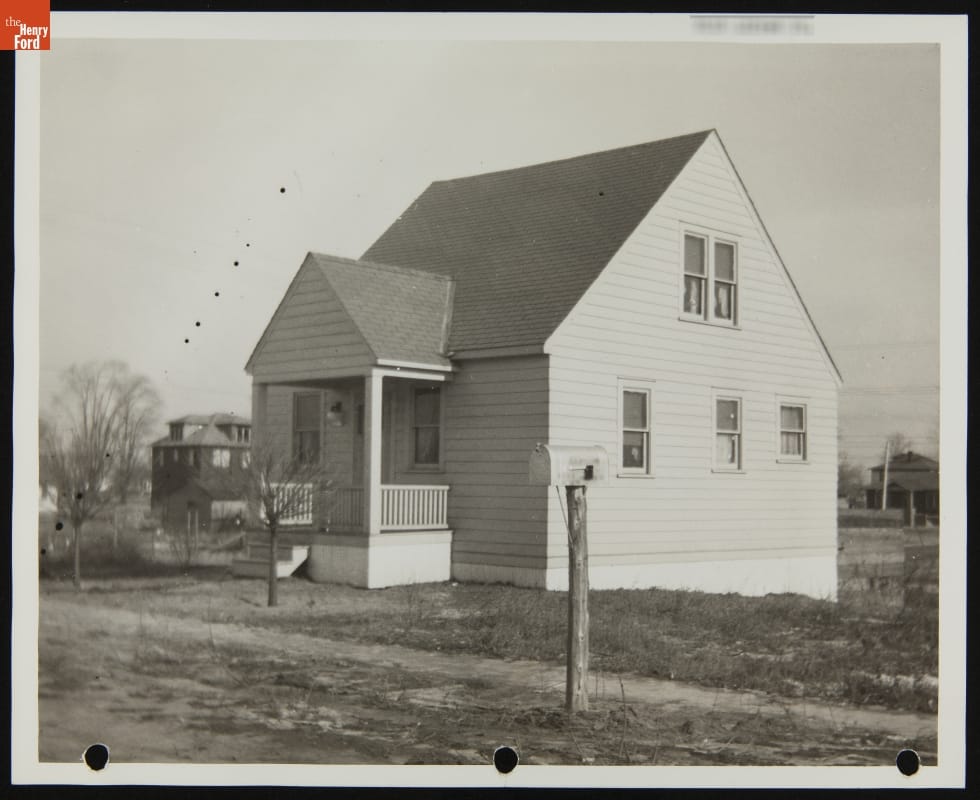
Photographic print - "Ford Motor Company Employee Home Improvement Project, Inkster, Michigan, 1930-1944" - Ford Motor Company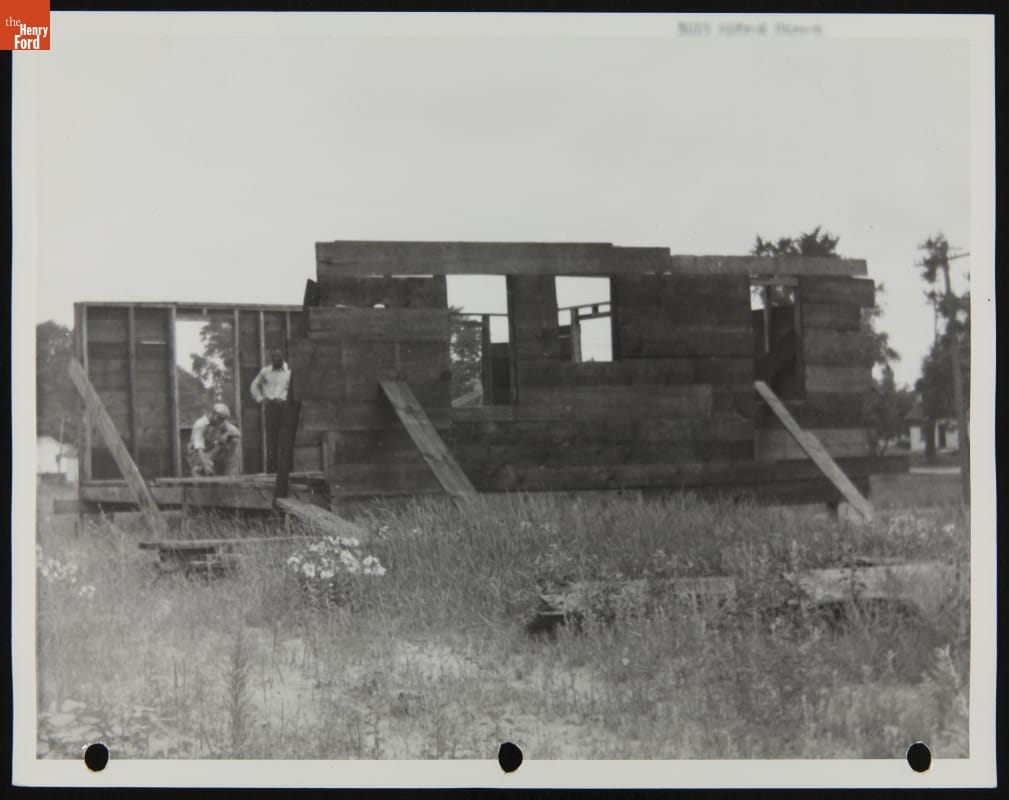
Photographic print - "Ford Motor Company Employee Home Improvement Project, Inkster, Michigan, 1930-1944" - Ford Motor Company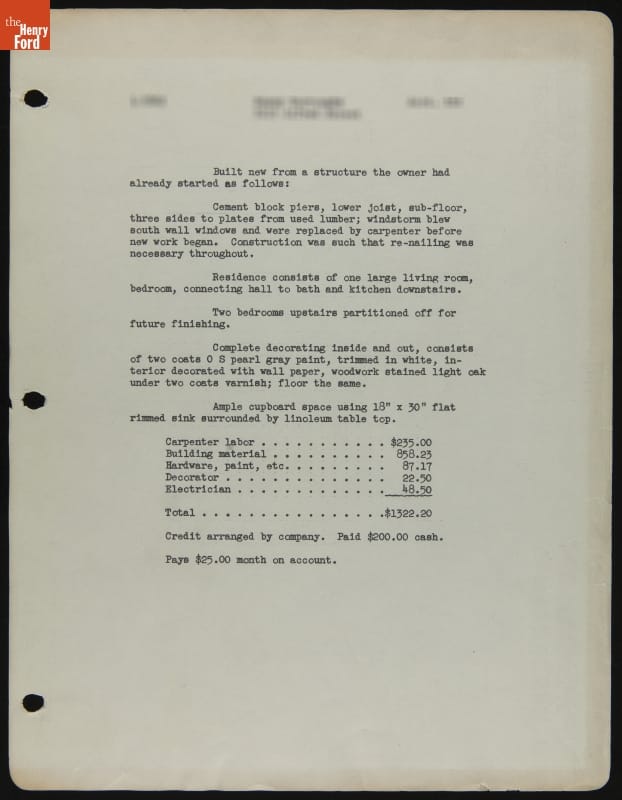
Report - "Ford Motor Company Employee Home Improvement Project, Inkster, Michigan, 1930-1944" - Ford Motor Company
By 1931, a few years into the Great Depression’s hardships, the residents of Inkster were struggling. Unemployment and debt were high, public services had been cut, and many residences remained partially-completed, as the Great Depression halted progress in the young village. Controversially, Henry Ford placed FMC’s Sociological Department in charge of what became known as the Inkster Project. The Sociological Department was created in 1914 in order to manage the diverse workforce and ensure employee adherence to the company’s strict standards, which were paternalistic in nature and often crossed the home life-work life boundary. In Inkster, the Sociological Department immediately began implementing programs to comprehensively rehabilitate the village. A commissary, which sold high-quality, low-cost food and essential home goods, was established. Coal was distributed to those who needed it to heat their homes. Debtors were paid off, and a medical clinic and school were constructed. Homes deemed insufficient were rehabilitated. The inability to pay for these services was irrelevant; a type of “I.O.U,” repayable through Ford-provided work and wages, was enough to access all life’s necessities.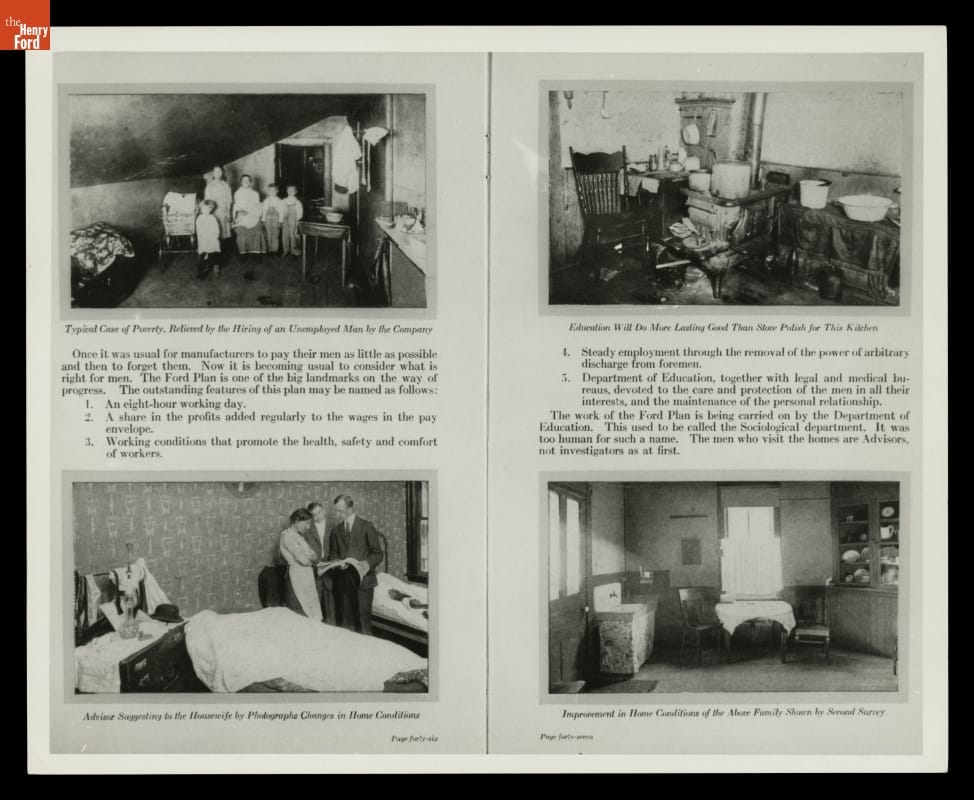
Photographic print - "Checking on Ford Employees Home Conditions, Views from "Factory Facts From Ford," 1917"
The Legacy of the Inkster Project
Although the Inkster Project was generally highly-regarded at the time, the FMC Sociological Department’s role was often overreaching. When agreeing to Ford’s aid, an Inkster resident was also agreeing to running their household as preferred by Henry Ford. Although his funds undoubtedly helped Inkster during the Great Depression, Ford’s motives were not entirely altruistic. Besides the much-needed public relations boost he received from the Inkster Project, he also was able to assert his influence and ideals on a community that largely had no choice but to accept his aid -- with all strings attached.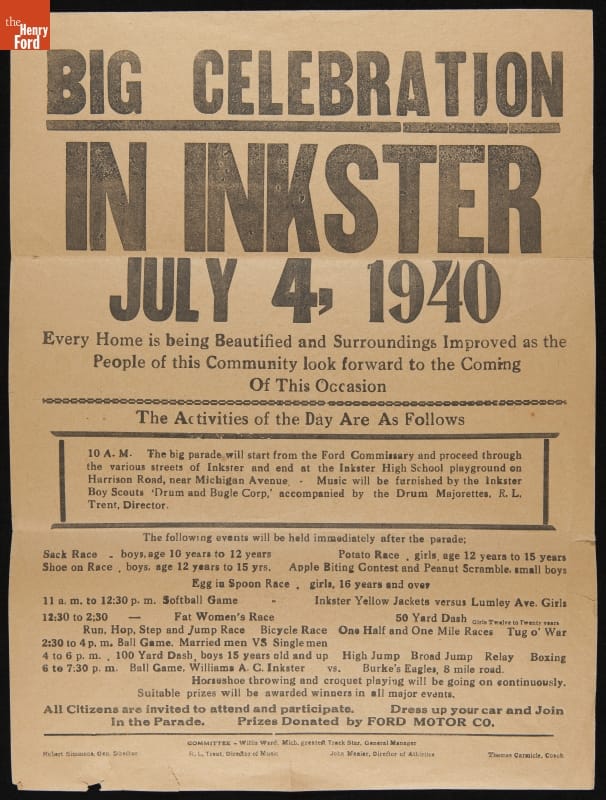
Broadside (Notice) - "Big Celebration in Inkster," July 4, 1940"
The Inkster Project’s legacy is complicated; many historians criticize Henry Ford’s paternalistic nature and the perhaps forceful imposition of his will onto the desperate, but others, including former residents of Inkster, praise Henry Ford for his aid. In her reminiscences, Georgia Ruth McKay explains that Inkster became a “jungle village changed into a city” during this period and that, “without his [Henry Ford’s] help, many would not have survived.” The Inkster Project was slowly phased out, but continued to operate in Inkster until 1941 when all programs were withdrawn.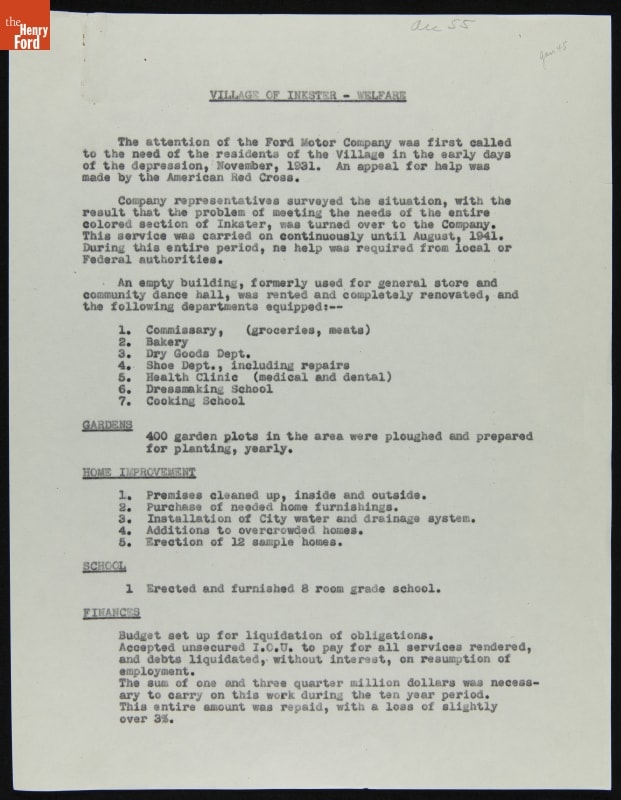
Progress report - "Village of Inkster Welfare Report, 1931-1941" - Ford Motor Company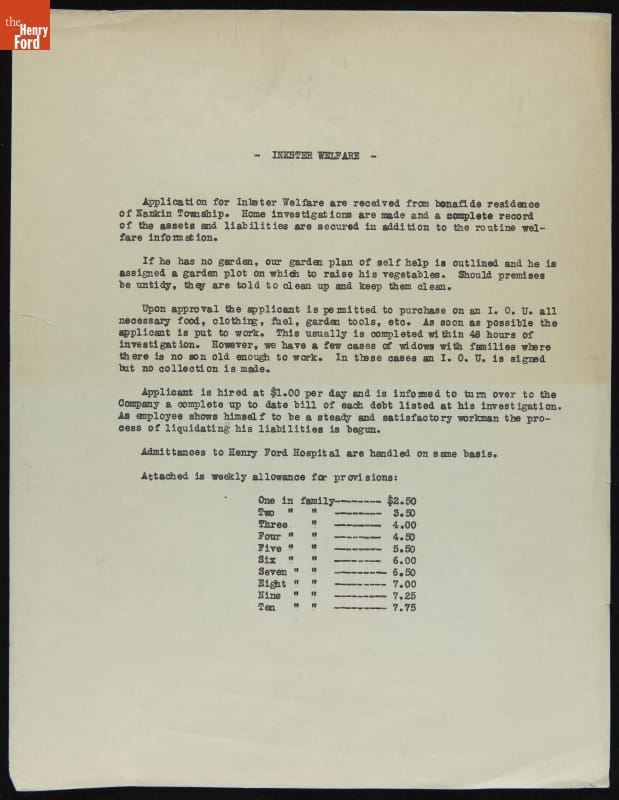
Report - "Village of Inkster Welfare Provision Report, circa 1936" - Ford Motor Company
Katherine White is Associate Curator, Digital Content, at The Henry Ford. In writing this piece, she appreciated the research and writings of Beth Tompkins Bates’ “The Making of Black Detroit in the Age of Henry Ford”, Thomas J. Sugrue’s “The Origins of the Urban Crisis; Race and Inequality in Postwar Detroit,”, and Howard O’Dell Lindsey’s dissertation, “Fields to Fords, Feds to Franchise: African American Empowerment in Inkster, Michigan.”
20th century, Michigan, labor relations, home life, Henry Ford, Ford workers, Ford Motor Company, Detroit, by Katherine White, African American history
An Attic Full of Stories

Evening Dress, Worn by Augusta Denton Roddis at Her Junior Prom, 1932. THF163503
From November 5, 2016 through April 2, 2017, The Henry Ford will present American Style and Spirit: 130 Years of the Fashions and Lives of an Entrepreneurial Family.
The exhibit features generations of clothing discovered carefully tucked away in a Wisconsin family’s attic. Rarely does one family preserve so many articles of clothing, spanning so many decades. And so often, family clothing that has been saved has lost its personal story. But not these garments.
This special collection of clothing from the Roddis family, with stories presented through photographs and heirloom objects, not only provides a glimpse into the lives of the Roddis family, it also connects us with stories of American life.

"Story Book Ball," Prom Dance Card, 1932. THF254843
Like the garments found in the Roddis family attic, clothing has meaning in our own lives.
Throughout the duration of the exhibit, we will continue adding links to this post that reveal more stories and show how clothing can provide a lens to the past.
Explore
The Roddis Family Collection
Learn
Elizabeth Parke Firestone Fashions
A Family's Fashions
In-House to On-the-Rack
A Wardrobe Workshop
When Fashion Mirrors Architecture
Watch

